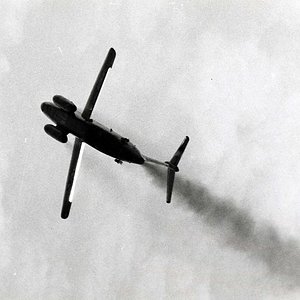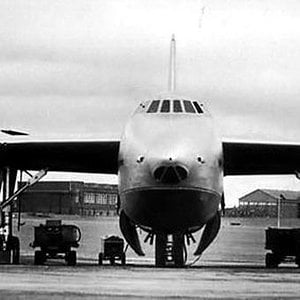Navigation
Install the app
How to install the app on iOS
Follow along with the video below to see how to install our site as a web app on your home screen.
Note: This feature may not be available in some browsers.
More options
You are using an out of date browser. It may not display this or other websites correctly.
You should upgrade or use an alternative browser.
You should upgrade or use an alternative browser.
Design and developmentUnited States Army Air Forces (USAAF) leaders in the Air Materiel Command began to consider the possibilities of jet-propelled bombers as far back as October 1943. At that time, Douglas Aircraft was just beginning to design a promising twin-engine bomber designated the XB-42. Reciprocating engines powered this aircraft but they were buried in the fuselage, leaving the laminar-airfoil wing clean of any drag-inducing pylon mounts or engine cowlings. The airframe appeared ideally suited to test turbojet propulsion. Douglas confirmed the feasibility of the concept and the USAAF amended the XB-42 contract in March 1944 to include the development of two turbojet-powered XB-43 prototypes, reduced from an initial order of 13 test aircraft.[1]
The Douglas design team convinced the Army that modifying the XB-42 static test airframe into the first XB-43 was a relatively straightforward process that would save time and money compared to developing a brand new design. Douglas replaced the two Allison V-1710 engines with a pair of General Electric (GE) J35 turbojets, then cut two air intakes into each side of the fuselage, aft of the pressurized cockpit. Removing the propellers and drive shafts freed enough space for two long jet exhaust ducts. Without the propellers, there was no chance of striking the blade tips on the runway, so the bottom section of the vertical fin was also removed. Douglas compensated for the loss of yaw stability by enlarging the upper vertical fin.
Douglas Aircraft was keen to mass produce the new bomber and the USAAF considered ordering 50. The company was poised to roll out as many as 200 B-43s per month in two versions: a bomber equipped with a clear plastic nose for the bombardier, and an attack aircraft without the clear nose and bombing station but carrying 16 forward-firing .50 in (12.7 mm) machine guns and 36 5 in (127 mm) rockets. Nothing came of these plans. The USAAF was already moving ahead with a new bomber, the North American XB-45 Tornado, designed from the outset for turbojet power and promising a quantum leap in every category of performance.
Specifications (XB-43)General characteristics
Crew: 3
Length: 51 ft 5 in (15.7 m)
Wingspan: 71 ft 2 in (21.7 m)
Height: 24 ft 3 in (7.4 m)
Wing area: 563 ft² (52.3 m²)
Empty weight: 22,890 lb (10,380 kg)
Loaded weight: 40,000 lb (18,000 kg)
Powerplant: 2 × General Electric J35-GE-3 turbojets, 4,000 lbf (18 kN) each
Performance
Maximum speed: 507 mph (440 kn, 816 km/h)
Range: 2,500 mi (2,200 nmi, 4,000 km)
Service ceiling: 38,500 ft (11,700 m)
Rate of climb: 2,470 ft/min (753 m/min)
Wing loading: 71 lb/ft² (350 kg/m²)
Thrust/weight: 0.20
Armament
Guns:
2 × 0.50 in (12.7 mm) machine guns in a remotely operated tail mount, never installed.
Planned attack variant: 8 × 0.50 in (12.7 mm) machine guns in solid nose
Bombs: 8,000 lb (3,629 kg)
The Douglas design team convinced the Army that modifying the XB-42 static test airframe into the first XB-43 was a relatively straightforward process that would save time and money compared to developing a brand new design. Douglas replaced the two Allison V-1710 engines with a pair of General Electric (GE) J35 turbojets, then cut two air intakes into each side of the fuselage, aft of the pressurized cockpit. Removing the propellers and drive shafts freed enough space for two long jet exhaust ducts. Without the propellers, there was no chance of striking the blade tips on the runway, so the bottom section of the vertical fin was also removed. Douglas compensated for the loss of yaw stability by enlarging the upper vertical fin.
Douglas Aircraft was keen to mass produce the new bomber and the USAAF considered ordering 50. The company was poised to roll out as many as 200 B-43s per month in two versions: a bomber equipped with a clear plastic nose for the bombardier, and an attack aircraft without the clear nose and bombing station but carrying 16 forward-firing .50 in (12.7 mm) machine guns and 36 5 in (127 mm) rockets. Nothing came of these plans. The USAAF was already moving ahead with a new bomber, the North American XB-45 Tornado, designed from the outset for turbojet power and promising a quantum leap in every category of performance.
Specifications (XB-43)General characteristics
Crew: 3
Length: 51 ft 5 in (15.7 m)
Wingspan: 71 ft 2 in (21.7 m)
Height: 24 ft 3 in (7.4 m)
Wing area: 563 ft² (52.3 m²)
Empty weight: 22,890 lb (10,380 kg)
Loaded weight: 40,000 lb (18,000 kg)
Powerplant: 2 × General Electric J35-GE-3 turbojets, 4,000 lbf (18 kN) each
Performance
Maximum speed: 507 mph (440 kn, 816 km/h)
Range: 2,500 mi (2,200 nmi, 4,000 km)
Service ceiling: 38,500 ft (11,700 m)
Rate of climb: 2,470 ft/min (753 m/min)
Wing loading: 71 lb/ft² (350 kg/m²)
Thrust/weight: 0.20
Armament
Guns:
2 × 0.50 in (12.7 mm) machine guns in a remotely operated tail mount, never installed.
Planned attack variant: 8 × 0.50 in (12.7 mm) machine guns in solid nose
Bombs: 8,000 lb (3,629 kg)








